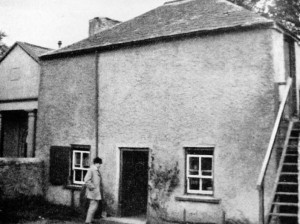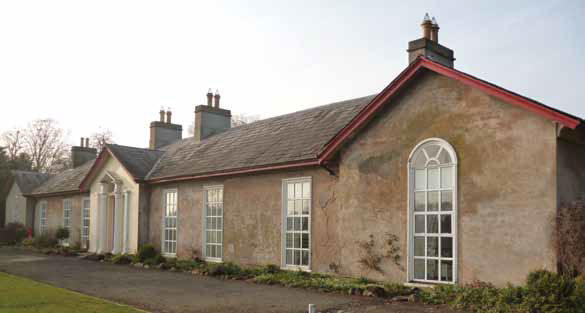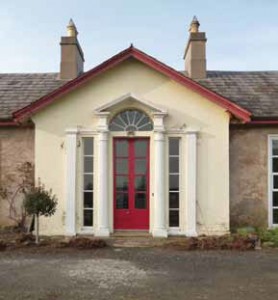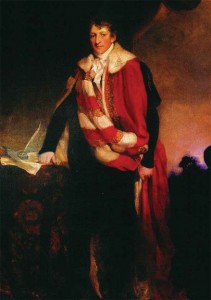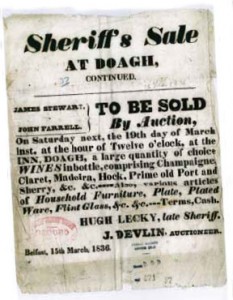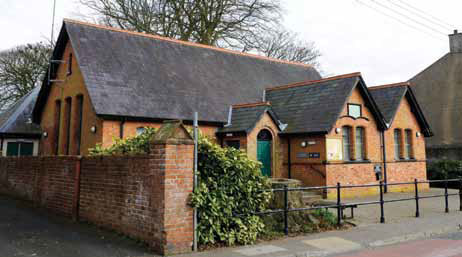At the beginning of the nineteenth century Doagh was a small, but growing village in the Sixmilewater valley. It was in the process of recovering from the damage caused by government troops in the aftermath of the 1798 rebellion.
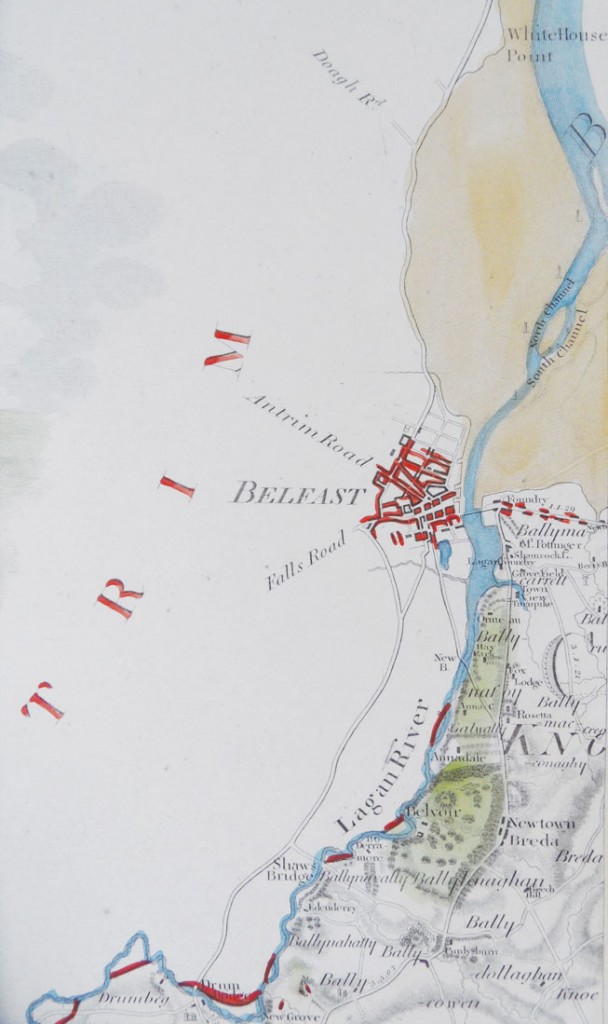
Detail from A Map of the County of Down taken from Actual Survey by James Williamson (1810) showing the road to Doagh
With the establishment of the Doagh Hunt in 1802, there was considerable excitement in the village on several occasions in the year when the well-to-do members of the Hunt arrived for their meetings. The money spent by the members of the Hunt and their entourage was a welcome injection into the local economy.
There were other indications of Doagh’s increasing importance. In the year ending 25 March 1805, Alexander Rule of Doagh was issued with a licence for ‘letting out horses to travel Post’.
Doagh’s location at the intersection of the roads leading from Antrim to Carrickfergus and Belfast to Ballymena made it a good location for setting up a postal establishment. John Dubordieu, in his Statistical Survey of the County of Antrim (1812), noted that there were 30 houses in Doagh.
School and book club revived
In the aftermath of their destruction, the supporters of the school and library set to work to restore both. By subscription they raised the funds needed and when it was safe to do so, they started to repair the damage. New items were purchased, fresh furniture was provided, the library was replenished and additions were made from time to time.
Within a few years the wreck of that devastation was no longer visible, except for the marks of musket butts on the shutters of the library.
In 1808 Samuel McSkimin published an account of a visit to Doagh in which he noted that in the village there was
nothing remarkable except its book clubs which are the most ancient and extensive in this part of the country, the people generally having a taste for literature. Much praise is due to Mr W. Galt for his exertions in promoting these and similar societies instead of the royal sport of cock-fighting …16
William Galt died aged 61 years on 7 January 1812. His funeral was immense. It was preceded by the children of the Sunday School and followed by the Masonic brethren of Lodge 294 of which he had been a member for 40 years. For some decades after his death, the library continued to be a centre for those with an inquiring mind and continued to prosper for many years.
In the late 1830s there were 30 active members of the Book Club who paid £3 entrance and 1s 6d per quarter. The library had at least 800 volumes in its possession. It also housed globes, scientific apparatus, and ancient and modern maps. However, by 1850 it had ceased to flourish, cheap newspapers, the penny periodicals and shilling novels all contributing to its decline.
Fisherwick Lodge
The most distinguished house in Doagh, Fisherwick Lodge was built at the beginning of the 1800s for the Marquess of Donegall and used by him as a hunting lodge and country retreat. Neither the Donegall estate maps of 1767-70, nor the Agnew estate maps of 1788 show a building where Fisherwick Lodge now stands and so it seems clear that it was constructed on a fresh site.
A fascinating deed of 10 July 1805 involving Lord Donegall and his brother-in-law Edward May senior and nephew Edward May junior reveals the circumstances in which Fisherwick Lodge was built.17
This deed recites a number of previous transactions concerning property in Doagh. Together these properties totalled some 20 acres. The deed then states that Edward May senior had advanced the sum of £6,400 in purchasing these lands for Lord Donegall and in ‘erecting and building a large dwelling house and offices thereon for the accommodation and reception of the said Marquis and family, and in planting and improving on the said premises’. However, as it was not ‘convenient’ at present for Lord Donegall to repay this sum, he agreed to mortgage these lands and the buildings on them to the Mays for the said sum of £6,400 plus interest.
A correlation of the properties mentioned in the above deeds with the Agnew estate map of Doagh clearly shows that they correspond to the location of Fisherwick Lodge. In having his brother-in-law to build the house and then mortgaging the premises to him, Lord Donegall was deftly evading his English creditors, to whom he owed huge sums of money. As Fisherwick Lodge was not strictly speaking in his possession, it could not be seized from him.
It was here that he took refuge after the contents of his house in Belfast had been seized in January 1806. His creditors were still keen to establish just what Donegall ‘owned’ and established that Fisherwick Lodge was ‘well furnished and has a demesne attached to it well stocked with cattle’ as well as containing a ‘great quantity of splendid and valuable furniture’.18
Fisherwick Lodge was admired by travellers for its architecture and for the fines grounds that had been developed around it. The anonymous author of ‘An excursion to Grace-hill’ that appeared in the Belfast Monthly Magazine in 1809 described the lodge as having been
built in the cabin style, and forming three sides of a square, the fourth being appropriated to the office houses; the windows are very large and extend from the foundations to the roof; before the door is a handsome, though small piece of water, and round the house are some young plantations of trees, with a variety of flowers and shrubs tastefully interspersed.19
Lord Donegall also had his kennels here which were used by the Doagh Hunt. From estate accounts that survive from the mid 1820s we know that William Johnson was the steward at Doagh and one Cavenagh was the cook. The bill from Rowan, the Doagh blacksmith, for keeping horses shod came to £82 12s. 9d. in November 1824.20 Today Fisherwick Lodge is owned by the Patton family.
While Fisherwick is the finest private residence in the village of Doagh, mention should also be made of the fine house at nearby Holestone built by the Owens family. In 1724 Henry Owens married a daughter of William Gilliland of Holestone. A descendant of this union, James Owens, ‘rebuilt and considerably enlarged’ the house here in 1827. The architectural historian Charles Brett has observed: ‘Its combination of austere exterior, richly laid-out interior, generous scale, and superb south-facing site, makes it as delightful as it is unusual.’21 The finely-cut ashlar of the front façade is said to have come from Scotland. The house is now the home of the Hamilton family.
Doagh in the 1830s
The Ordnance Survey Memoirs of the 1830s provide a great deal of background information on the character and habits of the people who lived in Ireland during the early part of the nineteenth century. In the late 1830s James Boyle of the Ordnance Survey made the following comments about the village of Doagh:
The village straggles irregularly for 150 yards along the road from Kells and Connor to Belfast. … Doagh consists principally of 1 street, 150 yards long and 38 feet wide. From the northern end of this a second branches off westerly for a few yards. The village consists of 46 houses and cottages. Of these, 7 are 2-storeys high, 35 are thatched and the remainder are slated. All are built of stone and lime, and all are roughcast and whitened. They are in general substantial and neat-looking, and though there has not been any regard paid to uniformity or regularity, still from its cleanliness and situation the appearance of the village is not unpleasing. … The population amount to 195 individuals, all of whom are of the humbler class and are engaged in some trade or dealing, or as farmers on a small scale. Almost all, in addition to their business, hold a little land. They are [a] peaceable and respectable class, and, particularly the more affluent, are enlightened and well informed.22
The oldest house was a two-story building that was believed to have been erected over 100 years before. It was then occupied by a farmer named James Harper, but was though to have once been a carman’s inn. It is possible that this was the original inn built c.1758 (and so not quite a century old). The inn that was used by the Antrim Hunt was generally reckoned to have been built at the end of the eighteenth century with 1799.
With regard to the other buildings in the village, Boyle wrote ‘There is nothing to which the term of public building can properly be applied’, though he did go on to draw attention to the library/school, the dispensary, and the Methodist meeting house. The dispensary had been established in Doagh in 1835. Boyle observed that ‘though its effects are not as yet actually perceptible, still it has been of great benefit to the lower class there.’ This dispensary covered a large area, taking in Ballyclare, Ballynure, Ballyeaston, Kilbride and Donegore. The industries in the village amount to two beetling or bleach mills and a flax mill, ‘on a rather limited scale’, and John Rowan’s forge.
James Boyle listed the following trades in Doagh and the numbers who followed each of them:
- Carmen 1
- Carpenters 2
- Cotton printers 1
- Farmers 5
- Grocers 2
- Innkeepers and publicans 2
- Labourers (agricultural) 2
- Labourers employed at bleach green 1
- Milliners and dressmakers 2
- Surgeons 2
- Schoolmasters 2
- Smiths (general) 1
- Weavers (linen) 3
- Wheelwright (1)
- Widows, old and unemployed 3
- Total 33
When it came to business in the village, Boyle felt that ‘There is neither trade nor commerce of any kind in Doagh, the petty shops supplying nothing beyond the mere necessaries of the inhabitants. Boyle believed that Doagh was then in decline, which he ascribed to a ‘failure in trade’.
The Doagh Hunt
On 1 December 1802 a meeting took place in Doagh at which it was ‘agreed to form a club’.23 The president of this club, which would be initially known as the Doagh Hunt and later the Antrim Hunt, was the Marquess of Donegall. There were 26 original members and henceforth those wishing to join had to be proposed by a member and then balloted with the stipulation that ‘One black bean to exclude’. It was agreed that the membership fee would be 3 guineas per annum. This was to be paid in September and anyone neglecting to do so would have to pay double at the next meeting. Cortland Skinner was appointed the first Treasurer.
Among the other items agreed at this first meeting was that ‘No musicians, petitioners, rafflers, or other vagabonds be suffered to attend or be paid by this Hunt’. Some members of the Hunt might well have though that Lord Donegall himself could be counted among these reprobates after he pocketed the money that had been given to him by the Hunt to purchase claret.
In the years that followed the Hunt grew in numbers, and by 1810 there were 68 members. They were mainly drawn from the south Antrim and Belfast gentry and aristocracy. However, not everyone who applied for membership was accepted. At the meeting of 8 October 1810 Thomas Pottinger Esq. suffered the indignity of being rejected by three black beans. The members of the Hunt dressed impressively. The uniform was scarlet in the field, with white buttons on each of which was depicted a hare and the initials ‘D. H.’. Evening dress was rifle green with yellow buttons inscribed ‘Merry Harriers’ and a black cape.
The headquarters of the Hunt was the inn in Doagh, which had been first built in 1799 by Edward Jones Agnew, and over the years various improvements were carried out to it to make it more suitable for members of the Hunt. At the Hunt meeting of 13 October 1806 it was ‘Proposed by Mr Verner that from Mr Agnew’s wish to add to the convenience of the Hunt, he be empowered to build a room and make such alterations in the present Club House as he may judge expedient.’ On 2 March 1812 Lord Donegall proposed that a committee should be appointed to draft a ‘plan and expenses of a club house’ for the Hunt and to collect subscriptions. On 30 September 1814 it was recorded in the minute book that on account of the ‘the improvements and repairs now taking place in the inn at Doagh not being in such a state of forwardness as to afford accommodation to the members of the Hunt’ the October meeting would be moved to Belfast.
The inn, often referred to as the hotel, was the most conspicuous building in Doagh in the early nineteenth century. In 1839 it was described as a ‘spacious building near the centre of the village. It measures in the exterior 68 by 26 feet and consists of a cellar and 2 lofty storeys.’ There was stabling for 70 horses and a ‘large and handsome clubroom’.24
In March 1815 the Hunt appointed a committee to settle with John Farrell, the innkeeper, on the charges to be paid to him by the Hunt. Following negotiations with Farrell, it was agreed that he would provide ‘wax candles, oysters, wild fowl, sloak, fruit, cook, waiter, beer, spirits, sugar, spice and lemons’. Farrell would be paid £6 per day for dinner, 16s. 3d. for breakfast (though should more than eight members of the Hunt breakfast a charge of 2 shillings each would be levied), 2 shillings per head for supper (‘to be regulated by the number at dinner the same day’), and 1s. 7½d. per head for tea and coffee. This arrangement was unanimously approved on by the Hunt.
Farrell, who was from Greyabbey, County Down, had an interesting relationship with the Hunt in the coming years. In October 1818, ‘In consequence of many complaints against Mr Farrell on account of his treatment of servants with regard to their beds, board, etc. and also with regard to his charges for livery, it was proposed to appoint a committee to investigate.’ The committee found that the servants’ beds were ‘very good and comfortable, with a sufficient number of blankets, etc’ and in sufficient numbers to accommodate all the servants likely to be staying with two to a bed. The committee also found that the servants’ ‘time of attending breakfast and dinner, etc was so irregular that Mr Farrell could not possibly please them’, and concluded that the complaints ‘originated very much in the servants themselves’ and so dismissed them.
If Farrell did not provide a service that was considered satisfactory by members of the Hunt he was liable to be fined. For example, in October 1820 he was fined 5 guineas for not having Carlingford oysters, though this was later rescinded when Farrell’s excuse that they could not be provided at that time was accepted.
Other fines included: 10 shillings for having damp straw in the stables in October 1823; 1 guinea for a ‘bad dessert’ in March 1824; 1 guinea for not having a list of bedrooms ready for members and 2 guineas for the stables being ‘out of order’ with broken windows in October 1825; and 1 guinea for the water closet being out of repair in October 1827.
A much more serious charge from 1824/5 was that Farrell had been using false measures for oats in the stables for several years. For this he was fined £10. Afterwards he wrote letters to the Hunt begging forgiveness for the ‘very irregular and improper conduct in his stable’.
Despite his own indebtedness, Lord Donegall was noted for his lavish hospitality during the meetings of the Hunt, prompting William Percy to pen the following lines in his ‘Panegyric Stanzas’ of 1826:
See Doagh throng’d with grandeur, see Farrell’s great Inn,
Where our fine Antrim Hunters festivity win;
Where a pattern’s afforded, admired by all.
Of the generous landlord in good Donegall.
Hark away! hark away! whilst we fervently pray,
That our kindest of landlords may still bear the sway.
The meetings of the Hunt in Doagh brought considerable excitement to the surrounding countryside and large crowds gathered to watch the members of the Hunt in action. In March 1828 it was reckoned that as many as 10,000 people had assembled to watch two steeple races.25 On one occasion the Newsletter commented, rather condescendingly, that ‘The conduct of the peasantry was admirable; whilst they enjoyed the sport, they behaved with the greatest decorum.’26
In the mid 1830s, Farrell fell into financial difficulties and in February 1836 was declared an ‘insolvent debtor’. It seems he had run up a large bill with James Stewart, a Belfast wine merchant, and had not been able to pay it. In mid March 1836 a ‘sheriff’s sale’ took place at the inn, Doagh. The items offered for sale included ‘a large quantity of choice wines in bottle, comprising Champagne, Madeira, Hock [German wine], Old Port and Sherry’, as well as various articles of household furniture, plate, etc. An explanation for Farrell’s fall into indebtedness can be found in the First Valuation fieldbook for the Grange of Doagh where in July 1836 it was noted that: ‘This Hotel is almost deserted in consequence of new roads being made in other directions to Belfast and is now three times too large for the place.’27
Farrell’s problems had consequences for the Hunt and a note in the minute book dated 1 May 1836 stated that no meeting took place during the remainder of that season due to the Hunt’s property having been ‘illegally seized’ by Stewart.28 An attempt was made to revive the Hunt’s meetings in Doagh the following year for it was resolved that if Farrell could provide security to the value of £600 by 12 May 1837 the October meeting could take place at Doagh. It seems that Farrell was unable to do so for there is no mention of a meeting at Doagh in October 1837. In January 1838 the Hunt decided to make the best arrangement they could with Farrell to obtain possession of the inn in Doagh. With Hunt meetings no longer being held in Doagh, the inn itself fell into decline. In February 1839 James Boyle of the Ordnance Survey wrote that the ‘spacious hotel is but party occupied and but a few of its rooms are furnished, and it is now nothing more than an ale house.’29
In April 1839 a committee was appointed to let the inn. The Hunt also discovered that Farrell was in the process of conveying some ground beside the inn to Rev. Johnston. However, Lord Donegall denied ever giving Farrell title to this ground and was willing to support the Hunt in dispossessing him. It was also reported that Johnston was himself interested in taking a lease of the inn. In order to clear its own debts, the Hunt held an after dinner auction of wine and claret on 10 April 1839, though a previous proposal to sell the Gold Cup was rescinded.
On 22 November 1839 the Hunt met at the Donegall Arms in Belfast, where in recent years, with the inn at Doagh not available, all of their meetings had been held, to discuss two proposals that had been received from George Miniss, the new proprietor of the inn. One of the proposals from Miniss was for the return of the furniture of the Hunt to Doagh; to this the Hunt readily agreed. The other proposal from Miniss was his offer to accommodate the Hunt at Doagh on the same terms as Farrell, except for the fines. It was agreed that as long as Miniss would have the necessary preparations in place the Hunt would meet in Doagh on the last Monday in January.
What happened next is not known for there are no further entries in the Hunt’s minute book. It seems that the Hunt folded shortly after this. Perhaps Miniss was not ready for a meeting at Doagh in January, and Johnston was not willing to relinquish his possession of the contested ground. The members of the Hunt may have simply tired of the difficulties they were encountering and given up. Over a decade later, on 9 November 1850, Colonel Verner wrote to his son Thomas on a matter concerning the ‘Doagh lease’: ‘I have no recollection of the Doagh lease … I am surprised Watson [James Watson Esq., the last president of the Hunt] did not take possession of the Cup and wine … it is long since the hunt was broken up’.30
The end of the Hunt was a massive blow for Doagh. As James Boyle observed in 1839, the ‘money circulated by the members of the retinues was considerable’, adding:
It has in its petty business greatly declined since the dissolution of the hunt club, which was the means of circulating a good deal of money among all classes. The farmers are not worse off than formerly, but the dealers and persons formerly employed about the hotel have felt its loss severely.31
Whatever hopes Miniss may have had for the inn went unrealised and in October 1843 the ‘old established and commodious inn’ and the farm of 16 acres that went with it were advertised in the Newsletter as an ‘eligible investment’. The inn was subsequently taken over by John Whiteside. By 1860 it had transferred to John Milford. In the Griffith’s Valuation fieldbook of c.1860 the following comments were made about the building: ‘Had been Club house for the Antrim Hunt Club. Milford does not occupy more than one third of the premises – altogether too large & unwieldy’.32 The inn continued to be used for a variety of purposes. For example, on an evening in June 1866 the Loyal Union Lodge (No. 5232) of Oddfellows, M.U. (Manchester Unity Friendly Society) celebrated their second anniversary in their lodge-room at the inn, with supper provided by Milford.33 Milford died on 14 May 1895. The inn was afterwards acquired by the McConnell family who remain its owners today.
Doagh National School
In 1832 the school held in the premises of the Doagh book club came under the Board of National Education. Following a visit on 20 December 1838, the schoolroom was described by James Boyle in the Ordnance Survey Memoir as being 22 feet by 16 feet and ‘too small for the purpose’. The school’s income comprised £10 from the Board of National Education and £2 2s. from the heirs of the late Edward Jones Agnew of Kilwaughter. In addition there was another £30 in fees paid by the pupils. At that time there were 18 boys and 27 girls at the school, 39 of them Presbyterians and the rest Church of Ireland. The master was William Johnson (or Johnston), a Presbyterian.
In his history of Kilbride, Rev. Cox refers to a successor to this school which was in the house known as ‘The Granary’ in Doagh, not far from the premises of the book club.xii A new school was opened in Doagh on the site of the present building in the early 1860s. According to a parliamentary report, the previous school building had been one of the worst in the area.35
In 1896 the Misses Douglas opened a Ladies School in the Torrens Memorial Hall in Doagh. This handsome brick-built hall had been opened in June 1885 and named after James Torrens, who had been the agent for the Donegalls and also the landlord of Doagh village. The need for such a hall had been long felt in the village and James Torrens had promised to make a major contribution to the building of a hall prior to his death. In the event it was erected in his memory by his widow and sons. The hall, which was capable of seating 300 people, had been built for the accommodation of Sunday schools and as somewhere that religious and other meetings could be held.36 After several years of classes being held here, the Ladies School moved to Ballyclare; it is regarded as a forerunner of Ballyclare High School.
16 Belfast Monthly Magazine, 30 June 1809, pp 423-4.
17 PRONI, D509/1573.
18 W. A. Maguire, Living like a lord (Belfast, 2002), p. 28.
19 Belfast Monthly Magazine, 31 August 1809, p. 107.
20 W. A. Maguire, ‘A resident landlord in his local setting’, in Proceedings of the Royal Irish Academy 83C (1983), pp 389-93.
21 C. E. B. Brett, Buildings of County Antrim (Belfast, 1996), p. 96.
22 Ordnance Survey Memoirs, vol. 29, pp 67-9.
23 The minute book of the Hunt is on deposit at the Public Record Office of Northern Ireland (D472/1).
24 Ordnance Survey Memoirs, vol. 29, p. 68.
25 Belfast Newsletter, 11 March 1828.
26 Belfast Newsletter, 3 Dec. 1830.
27 PRONI, VAL/1B/17A.
28 Stewart may have equated with the James Stewart who appears in a Belfast directory of 1835/6 as a wine and spirit merchant in 10 Legg’s Lane, Cherry-vale.
29 Ordnance Survey Memoirs, vol. 29, p. 68.
30 PRONI, D1798/8/5.
31 Ordnance Survey Memoirs, vol. 29, p. 68-9.
32 PRONI, VAL/2B/7B.
33 Belfast Newsletter, 13 June 1866.
34 Cox, History of the Parish of Kilbride, p. 58.
35 The twenty-ninth report of the Commissioners of National Education in Ireland (for the year 1862), vol. I (1863), p. 176.
36 Belfast Newsletter, 8 June 1885.
